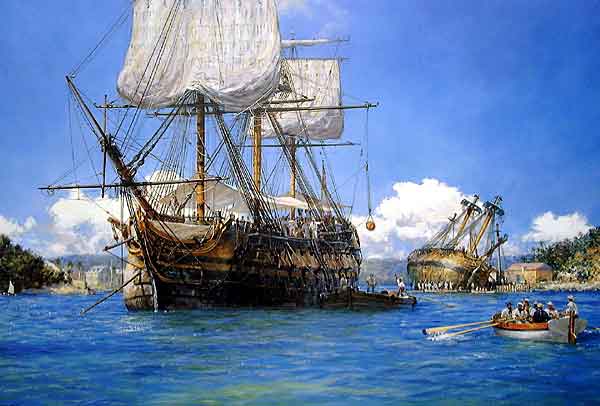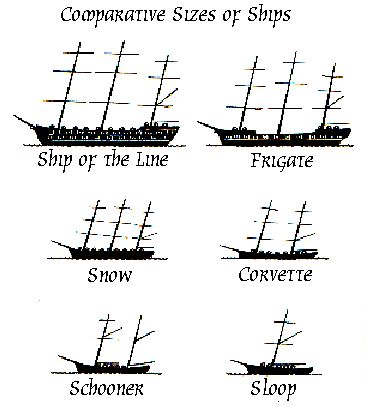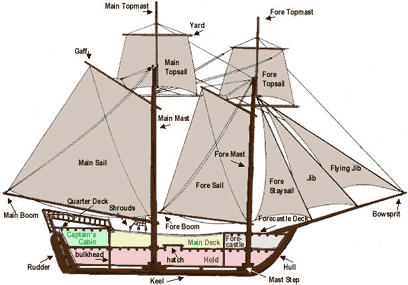Caribbean Tales - Ships

Ship: from the Old English scip, the generic name for sea-going vessels (as opposed to boats). Originally ships were personified as masculine but by the sixteenth century almost universally expressed as feminine. In strict maritime usage signified a vessel square-rigged on three masts.
Pirates of old used many types of ships, anywhere from a small sloop to a large warship. But generally they gave preference to those with the greatest speed as it would do no good to spot a potential target only to have it out-sail you. Also pirates wanted a quick escape if needed. The pirates kept their ships in good order, careening them regularly to keep the hulls smooth and clear of seaweed and other marine life. This work was essential in order to maintain their speed advantage. Two of the pirates favorite types of ships were the sloop and the schooner. The speed and shallow draft of these ships enabled the pirates to hide in relative safety in shallower coastal waters where larger warships could not enter.
Pirate ships had unusually large crews
There were up to eighty pirates per ship. In contrast, most English ships
had only thirty men. Work was evenly distributed among the pirate crew, and
so jobs got done faster with less strain than on traditional colonial ships.
Many considered a berth on a pirate ship easy pay for little work. In
many cases, pirates wouldn’t have to fire a shot. The mere approach of
a pirate ship would cause most colonial captains to surrender. Then the captured
captain would try to make some sort of deal that would result in the least
amount of death and injuries. This often worked - but not always! There were
many pirates - Blackbeard for one - who engaged in ruthless, bloody brigandage
for the sheer sport of it.
|
Ship Types
|
|
| Barque | Lighter: large, open, flat-bottomed boat, with heavy bearings, employed to carry goods to and from ships. |
| Brigantine | Longboat: much like a rowboat except they were very long. They were carried on ships and used for coming and going to the ship. They were normally rowed but often had a removable mast and sail. |
| Caravel | Lugger: small vessel with four-cornered cut sails, set fore-and-aft, and may have two or three masts. |
| Carrack | Packet: small vessel usually used to carry mail between ports. |
| Cutter | Pinnace: 28 feet long, small fast vessel that could be rowed or sailed. It was often the largest of a warship's 'jolly boats' and acted as a small transport vessel. It could be powered by 8-16 oars. |
| Dutch Flute | Man-O-War/Ship-of-The-Line |
| East Indiaman | Merchant/Pink |
| Fire Ships: small vessels used especially by the Dutch, but by all navies generally. The Spanish Treasure fleet used them. The ship is lightly crewed by very brave men. They appear mostly to be recycled older ships. However, by small, it should be understood in naval terms. One record tells of an ex-30 gun ship modified as a suicide fire ship. The vessels were usually cut down normal ships, and in times of use had their lower decks stuffed with as much flammable material as practical. The lower gun ports were reverse hung, so that should the covers burn, they would not fall down to block the port and therefore starve the fire inside. A disembarkation door was fitted to the waterline deck so the crew could make a hasty retreat to a waiting rowboat. When time was sufficient, they were fitted with grappling irons to the ends of the yards so that once entangled, they were difficult to disentangle. | Schooner |
| Frigate | Sloop |
| Galleon | Snow |
| Galley | Tender: vessel used to assist or serve another, an auxiliary vessel. |
| Gig: light, narrow ship's boat, built for speed. | Transport: cargo vessel engaged by the government to convey troops, convicts, or stores, invariably these were chartered merchantmen - the Navy owned and manned only a small number. |
| Jollyboat: small ship's boat, used for a variety of purposes. Clinker-built, propelled by oars, and was normally hoisted on a davit at the stern of the ship. | Xebec/Shebec |
| Ketch | |
| Typical Battle Tactics | Typical Personnel/Crew |
| Known Ships and their Captains of the Caribbean | |
 |
|
Some Basic Parts
of a Ship
|
|||
|
Sails Flying Jib |
Rigging Bowsprit |
Hull Stern |
 |
Ship Maintenance
Careening
For all vessels operating in the Caribbean, speed was important. For pirates
it was critical. As ships were immersed in water continously for the extent
of their natural life, their hulls became mini habitats for marine life -
barnacles, algae and sea worms mostly. This irregular surface on the timber
lines increased drag and slowed the ship down a little, and was serious enough
to make captains maintain regular maintenance on the hull below the waterline.
Careening also meant the ship was out of commission for the period and hence
made pirates particularly vulnerable, and hence was carried out in very secluded
well protected bays and inlets. Merchants and naval vessels could at least
careen in or near town.
Basically the ship was brought to shore at high tide and pulled over on its
side by ropes attached to the masts. The carpenter and mate were in charge
of the process, with much of the crew helping to scrape & burn off algae
and barnacles, remove rotten planks and fix new ones, caulk the gaps between
planks to remain water tight, and look for signs of infestation of sea worms
or rot. Careening could take up to 10 days for professional results, and needed
to be conducted every 2 months or so, though the pirate histories I have read
seem to indicate more likely yearly careening was usual.
Caulking involved beating oakum into every seam, or between planks.
Oakum is old rope torn to pieces which is beaten into seams with a caulking
iron and a wooden mallet with an iron chisel. It is then well smeared over
with hot pitch to make it as watertight as possible.
Graving is used on the underwater sections of the hull, and consists
of a mixture of tallow, soap, whale/seal/fish oil, resin and brimstone boiled
together and painted over the timber to protect the caulking and make the
ships hull smoother under the water line. It is also possible to also sheath
the hull, which is to coat the hull with tar and hair, and nail a layer of
thin boards over the top.
Breaming is simply washing or burning clean the hull with reeds or
a bristled plant.
Parcelling is deck work, involving laying long strips of canvas in
seams between planks and sealing them with caulk and hot pitch.
Storms were also a major cause of concern
to the hulls of ships. Timber is a natural flexable material, and under the
stress of heavy wave pressure, the hull boards and superstructure will shift
and cause the seams between hull planks to open and split the caulking, causing
small leaks. This is generally not a major concern as seams are always leaking
somewhere which is why you have bilge pumps. However, vigilance is important
and the carpenter will be kept busy attending the hull after storms.
 |
One of the biggest enemies to these ships, and others, weren't pirates or Naval officers, but worms! The teredo worms (mollusks) infest tropical waters and like to make their homes in the wood of a ship's hull. The worms have shells that remain after the critter has moved on and these shells, like barnacles, build up to rob a ship of her speed and seaworthiness. A ship had to be coated with a mixture of tar, tallow and sulfur two or three times a year to prevent these sorts of pests. Also, a ship with such pests would have to be careened to regain her ever-so-important speed and agility. It was during careening that many a pirate met up with an adversary hoping to catch him in such a state of unpreparedness. |